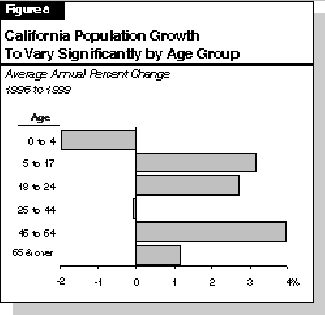
 |
California's Fiscal Outlook |
Economic and demographic trends generally are the principal determinants of the state's fiscal condition, including revenues, expenditures, and the budget surplus or deficit. This chapter presents our economic and demographic projections through 1999 that will influence the state's fiscal position in 1996-97, 1997-98, and 1998-99.
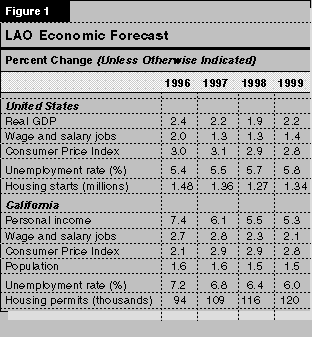
After slowing sharply in 1995, U.S. real gross domestic product regained momentum in early 1996, and appears to have settled into a growth rate of between 2 percent and 2.5 percent as of the second half of this year.
California wage and salary employment growth has accelerated over the past year, and is now showing year-over-year increases of more than 325,000 jobs, the strongest gains since the late 1980s.
Main Features of U.S. Outlook. U.S. economic growth over the next three years is expected to be led by above-average increases in business investment (particularly in computers and related electronic equipment) and by continued gains in exports. Consumer spending is forecast to increase at about the same rate as the overall economy--slightly more than 2 percent per year in inflation-adjusted terms. High consumer confidence levels and steady job growth should be positive factors. However, relatively high consumer debt levels are likely to hold future gains in consumer spending to increases which are no greater than those of personal income. Slower growing sectors include residential construction and government spending.
Figure 2 provides a broader perspective on one of the state's most important economic variables--personal income. The growth of this measure slowed sharply during the early 1990s' recession before accelerating beginning in 1994. We estimate that personal income growth will peak at 7.4 percent this year, reflecting healthy gains in employment, wages, investment earnings, and business income. The measure is projected to grow at more moderate rates in 1997 through 1999, as the state's expansion matures.
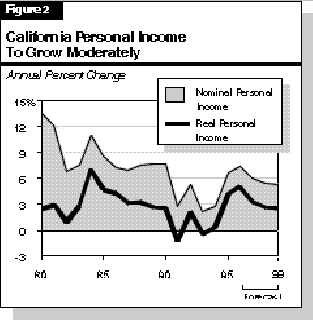
Although the rate of economic growth in California is expected to subside over the next three years, the increases in employment and income will likely exceed the nation as a whole by a significant margin (see Figure 3). This expected above-average performance is partly due to the positive outlook for many of California's key high technology and export-related industries. It also reflects the fact that this state is in an earlier stage of its economic cycle than the nation as a whole, and thus has more "room" to expand.
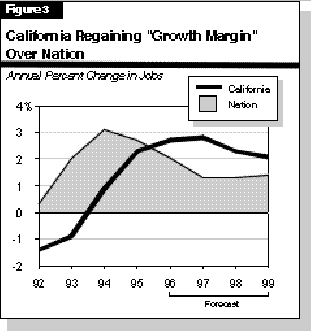
California's Economic Expansion Is Becoming More Broad-Based. As shown in Figure 4, virtually all major private industry sectors are projected to grow over the next three years. The breadth of the expansion is a positive factor because it means the state is not overly dependent on any single industry for continued future growth.
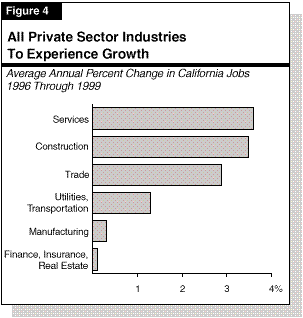
The fastest growing industries are projected to be services--including gains in such business-related areas as software design and management consulting, and in tourism--as well as the trade and construction industries.
The slowest growing industries are projected to be manufacturing and the finance, insurance, and real estate sector. The performance in even these sectors, however, represents a marked improvement from their poor experience in recent years caused by sharp declines in the aerospace and banking industries. Both of these sectors have bottomed out in recent months. This has been a positive development, especially for Southern California, which had borne the brunt of the above-noted declines in aerospace and banking.
Home Construction To Recover Slowly. Home construction remains the weakest area of California's economic outlook. Despite improving home sales, permits for new residential construction will likely remain below 100,000 units in 1996, or less than one-half of the average during most of the 1980s. The weakness is most pronounced in the multi-family market, where new construction remains at only about 15 percent to 20 percent of the 1980s average.
Continued softness in new home prices in key regions of the state, coupled with a large inventory of existing homes on the market, appear to be contributing to the ongoing weakness.
Our forecast assumes that continued job and income growth, coupled with modest increases in home prices, will lead to higher construction rates during the next three years. However, as shown in Figure 5, we project that home construction will remain well below the levels routinely achieved during most of the 1980s.
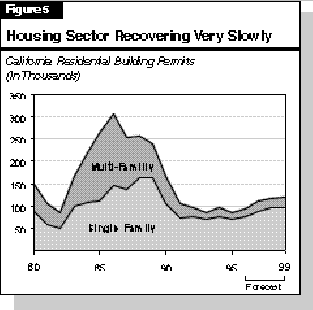
Although our economic forecast is consistent with the consensus view of economists generally, economic performance over the next couple of years could differ from our projections. For example, although few economists are predicting a recession in the near future, one popular alternative economic scenario is that, given the length of the current national economic expansion, the economy could experience a slowdown. Should this occur, our economic forecast and the General Fund fiscal outlook that we are projecting would prove overly optimistic.
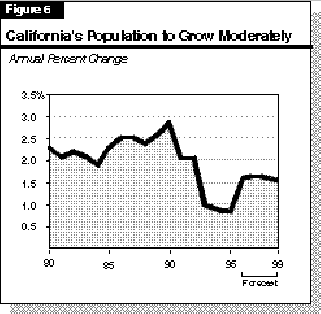
Population Growth Components. California's population growth consists of two main components--natural increase (births minus deaths) and net migration (persons moving into California from other states and nations minus people leaving the state). We project that natural increase will average slightly over 300,000 annually, while net migration will be about 225,000 annually.
Modest Upswing in Net Migration. As Figure 7 shows, net migration is the main reason why the state's population growth has rebounded from its recessionary lows, but nevertheless remains well below its previous peaks. Net migration turned negative during the recession after having exceeded 400,000 previously. This was mainly due to a net domestic out-migration to other states, which peaked at 345,000 in 1994 due to California's especially severe recession. We expect net domestic out-migration to slow considerably, to about 25,000 per year in the late 1990s. With regard to foreign migration, we are projecting a net inflow of 250,000 annually, only slightly less than the average for the first half of the decade.
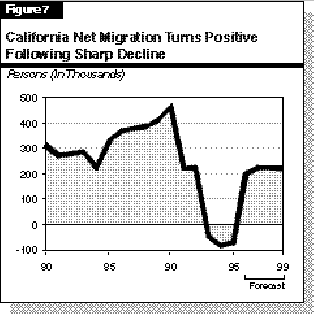
Growth to Vary by Age Group. Figure 8 (see next page) shows our population growth projections by age category. The most rapidly growing groups are K-12 school-age children (reflecting past birth-rate patterns) and the 45-64 age group (aging baby-boomers). These various age-group projections have significant implications for state expenditures in many different program areas, including education, health, and welfare. For example, population growth in the 5-17 and 18-24 age groups influence K-12 and higher education enrollments.
